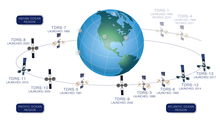TDRS-1
During this time, a severe storm caused contamination of TDRS-1 while it was in the Payload Change-out Room on the Rotating Service Structure at the launch pad.
[4] Challenger finally lifted off from Launch Complex 39A of the Kennedy Space Center at 18:30:00 UTC on 4 April 1983.
[10] Over the years, the orbital inclination was allowed to increase so that, for portions of the day (approximately 5 hours), it was able to be used for communications with the North and then the South Pole.
Along with Marisat F2, GOES 3 and LES-9, it was one of a number of satellites that were transferred to the US National Science Foundation in 1998,[11] for communications with the Amundsen–Scott South Pole Station.
[12] The last functioning traveling-wave tube amplifier aboard TDRS-1 failed in October 2009,[11] rendering the spacecraft unusable for communications purposes.
Doctors in the United States aided Dr. Jerri Nelson, who had breast cancer, in performing a self-biopsy and administering chemotherapy.
